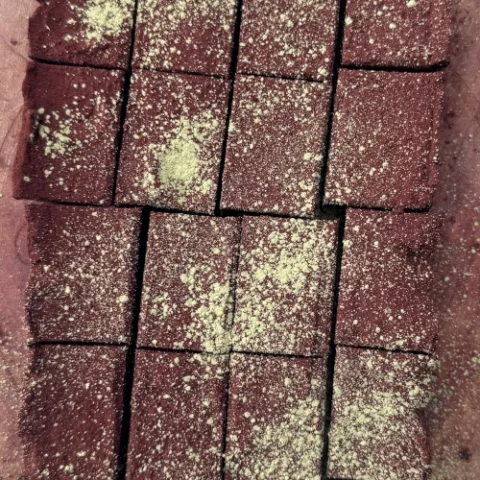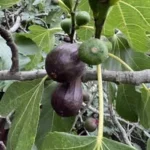
Dates, Chocolate and Matcha cake
This no-bake treat comes from the United States, though the word cake can be a little misleading — it’s closer to snack bars or finger food. Packed with walnuts, dates, and dark chocolate, these slices are naturally sweetened and full of texture. Matcha adds an earthy depth and a vibrant green touch, while also bringing its well-known benefits: gentle energy from natural caffeine, potent antioxidants, and a calming effect thanks to L-theanine.
Think of this as a wholesome yet indulgent pick-me-up — perfect with an afternoon coffee or tea, or as a nourishing post-workout snack.
Ingredients
- 135 g walnuts
- 90 g Medjool dates
- 2 tbsp almond flour
- 3 tbsp unsweetened cocoa powder
- 2 ½ tsp matcha powder
- 2 tbsp maple syrup
- 1 tsp vanilla extract
- 90 g dark chocolate chips, melted
- 1 tbsp ground ginger
Instructions
- Line a 20 × 10 cm loaf tin with parchment paper.
- In the bowl of a food processor, crush the walnuts, then add the dates and blend until chopped and sticky.
- Add the almond flour, 2 tbsp of cocoa powder, 1 ½ tsp matcha, maple syrup, vanilla, and melted chocolate. Blend until smooth. Transfer to a mixing bowl, add the ginger, and stir to combine.
- Press the mixture firmly into the prepared loaf tin, smoothing the top with a spatula. Cover with plastic wrap and refrigerate for 3 to 4 hours.
- Cut into 2.5 cm slices. Dust with the remaining cocoa and matcha before serving.
Matcha: Origins, Nutrients, and Fun Facts
If you’ve ever enjoyed a Dates, matcha and chocolate cake, you already know how unique matcha can be. This finely ground green tea powder from Japan has become a global superfood, loved for its earthy flavour, vibrant colour, and health-boosting properties. Let’s explore its origins, what makes it so nutritious, and some fascinating fun facts.
The Origins of Matcha
Matcha’s story begins in China during the Tang Dynasty (7th–10th century), when tea leaves were steamed and pressed into solid bricks for easier transport. These tea blocks were later ground into a fine powder before being whisked with hot water. This early preparation technique laid the foundation for what we now know as matcha.
By the 12th century, Zen Buddhist monks introduced this powdered tea method to Japan. They quickly adopted it into their meditation practices, as the combination of caffeine and L-theanine provided calm focus and sustained energy. Over time, matcha became deeply intertwined with Japanese culture, particularly through the tea ceremony (chanoyu), which values harmony, respect, purity, and tranquillity.
Today, Japanese matcha is considered the gold standard, with regions like Uji in Kyoto and Nishio in Aichi Prefecture producing the finest varieties. The meticulous cultivation process — shading the plants before harvest to increase chlorophyll and amino acids — is what gives authentic matcha its vivid green hue and complex umami flavour.
The Nutritional Power of Matcha
Unlike steeped green tea, where you discard the leaves, drinking matcha means consuming the whole leaf — making it far more nutrient-dense. Here are some of its top benefits:
- Rich in Antioxidants: Matcha is rich in catechins, particularly EGCG, which is known to combat oxidative stress and support heart health.
- Natural Energy Boost: Thanks to a combination of caffeine and L-theanine, matcha provides sustained energy without jitters or crashes.
- Supports Focus & Calm: L-theanine promotes alpha brain waves, enhancing mental clarity and calmness.
- Detoxifying Properties: The high chlorophyll content supports detox and overall wellness.
- Vitamin & Mineral Source: Matcha contains vitamins A, C, E, K, and minerals like potassium, iron, and calcium.
When used in recipes like Dates, matcha and chocolate cake, these benefits are combined with the natural sweetness of dates, the healthy fats of walnuts, and the antioxidants of dark chocolate, creating a snack that is both indulgent and nourishing.
Learn more: Health Benefits of Matcha – Healthline
Fun Facts About Matcha
- Samurai’s Secret Weapon: Matcha was once consumed by samurai before battle for energy and focus.
- Traditional Whisking: Authentic matcha is whisked with a bamboo whisk (chasen) to create a frothy, smooth drink.
- Two Grades Exist: Ceremonial grade (best for drinking) and culinary grade (great for recipes like our Dates, Matcha & Chocolate Cake).
- Cultural Symbol: The Japanese tea ceremony (chanoyu) celebrates mindfulness, harmony, and respect through the preparation of matcha.
Why add Matcha to desserts
Matcha isn’t just for lattes. Adding it to desserts like this Dates, matcha and chocolate cake gives your recipe an earthy balance to natural sweetness while boosting nutrition. The combination of energising antioxidants, healthy fats from walnuts, and natural sugars from dates makes this no-bake cake a guilt-free indulgence.
The combination of energising antioxidants from matcha, natural sugars from dates, and nutrient-rich walnuts makes this no-bake cake both satisfying and guilt-free. It’s the perfect choice for an afternoon pick-me-up, a tea-time treat, or even as a nourishing post-workout snack.
Try this vegan matcha recipes.
Final Thoughts
The next time you crave a treat, remember that desserts can be nourishing, too. This dates, matcha and chocolate cake brings together history, culture, and health benefits in every bite. Whether enjoyed with tea, coffee, or as a post-workout snack, it’s the perfect balance of indulgence and wellness.



